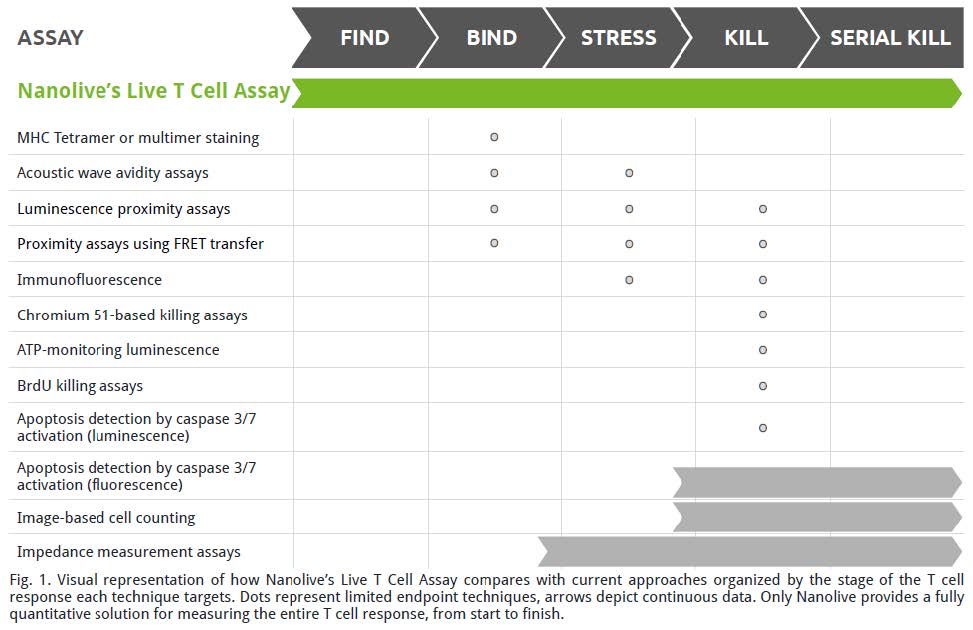Nanolive, a Swiss life sciences company renowned for its innovative solutions to combine screening, imaging and analysis of living cells, launched the ground-breaking Live T Cell Assay. The event was marked with an online launch event.
The Live T Cell Assay is the first multi-parametric, label-free live immuno-oncology assay that is able to measure and characterise in one experiment how T cells find, bind, stress, kill and serial kill their targets and to select the best T cell therapy forn living cells. This new digital assay represents an evolution of Nanolive’s imaging solutions, which set the benchmark for label-free live cell imaging and analysis by enabling new features and automation capabilities as well as dramatically simplifying the experimental workflow.
“By combining Nanolive’s unique label-free data-rich images with advanced AI and computer vision, our Live T Cell Assay will bring new answers to the field of immuno-oncology and address open therapeutic and research challenges,” says Dr. Mathieu Frechin, Head of AI for quantitative biology at Nanolive.
Innovative immuno-oncology research and therapies require advanced analysis tools. Tools currently available on the market focus on one specific analysis giving limited and often indirect measures of the interactions that occur between T cells and target cells (Fig. 1).

The high attrition rates of drug candidates make technologies that can measure the biological complexity of our immune system through multiplexed, unbiased metrics highly relevant for researchers. Comprehensive characterisation of the effects of compounds on interactions between T cells and target cells in the early stages of the drug discovery process holds the potential to improve efficacy downstream and thus presents the best chance of clinical success in the future.
In fact, the T cell response toward target cells can be divided into five phases: find, bind, stress, kill, and serial kill. Nanolive’s label-free live cell imaging captures detailed, multiplexed, and texturally rich images of the entire process, and thus, offers a unique opportunity to understand T cells and target cells interactions over time, at both the single-cell and population level. The richness of the data though poses a considerable analysis challenge. Different cell types must be identified, segmented, and meaningful metrics extracted if significant conclusions are to be drawn.
One of the most challenging aspects of analysing live T cell dynamics for any technology is discriminating T cells from their targets. Only Nanolive’s data rich images can achieve this clear segmentation without using destructive labels.
By combining artificial intelligence (AI) with advanced computer vision, Nanolive’s Live T Cell Assay can distinguish T cells from target cells in a label-free manner and follow their interactions in real-time. This
allows users to quantify the dynamics of the two cell populations and automatically extract the timing and entity of key events in the T cell response to be calculated, including- but not limited to- the time at which T cells initially bind to their targets, the time at which signs of phenotypic stress are shown by the target cells, and the time at which the first killing events are detected.
In addition to this Nanolive’s Live T Cell Assay quantifies how many target cells a single T cell is able to kill over the duration of the experiment, providing a robust and user-friendly solution for comparing how drugs or treatments of interest influence individual T cell effectiveness.
“This is the first time we are able to see so nicely the killing process of T cells involved in in-vitro assays. We can also extract additional very important criteria and key parameters like the T cell killing and the killing rate but we can also determine the average of cancer cells killed by one T cell which is very important because this type of parameter is not easily extracted from a conventional method,” says Valery Moine, Head of Pharmacology Unit Light Chain Bioscience.
Nanolive’s new product provides a complete quantitative summary of T cell behaviour by providing multi- parametric data for every cell at every time point.
Nanolive’s label-free solution offers a simple, robust, and unbiased potency assay for cell therapies, which promises to bring greater detection sensitivity and enhanced accuracy to the evaluation of next generation immuno-therapy candidate drugs, chimeric antigen receptor (CAR) T cells, and T cell receptor (TCR) modified T cells.
